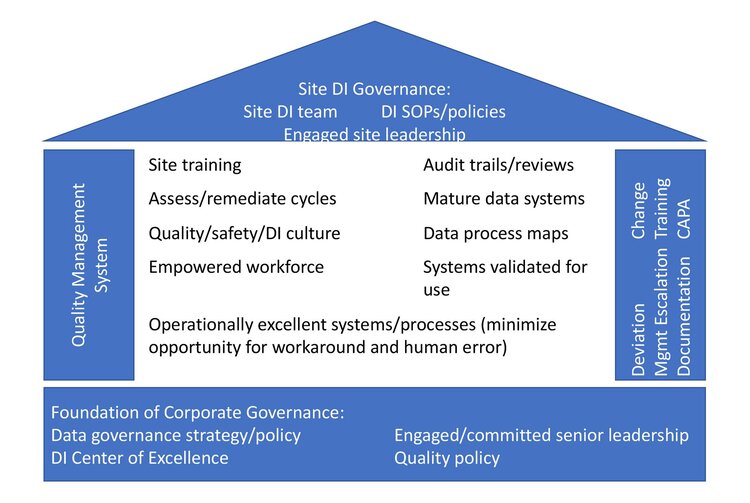Many years ago, my uncle built his own house and I had an opportunity to see how a house goes up in the non-commercial construction context. The first thing that I noticed is just how long it takes to build a home when you self-fund and largely perform construction yourself. Second, I realized that you need to carefully plan the sequence of construction phases because it may take quite some time before moving to the next phase. Finally, you still need a place to live while building the house! Building a Data Integrity (DI) program from the ground up is no different.

The Foundation
A foundation provides the stability and structure on which the rest of the house is built. No matter how fancy or well-built rest of the house, a faulty foundation will eventually cause the entire structure to fall. DI program elements that I think of as foundational are:
-
A clear Quality Policy that supports DI outcomes and lays out how the rest of the Quality systems interact with the DI program.
-
A Data Governance Strategy or Policy that establishes the DI philosophy at the company, and procedural and systemic controls for governing data throughout its lifecycle.
-
Engaged and committed senior leadership who understand DI, how it supports product quality, and who support DI programs and work practices.
-
A DI Center of Excellence, comprised of DI professionals from a variety of backgrounds to develop and lead DI initiatives, work with sites and departments to cultivate DI systems and ways of working. This group will also coach and mentor leaders at all levels to help them build cultures of excellence in their teams.
While a foundation is necessary, it isn’t by itself fully sufficient. We have a strong base of support on which to build the rest of the house, but we still don’t have a habitable structure For that, we need to build some walls.
The Walls
Walls give a house strength, they enclose the interior, and hold up the roof. In this model the walls are made up of the Quality Management System in all of its elements: Deviation and Corrective Action systems, Change Management, Training, Documentation systems, and Management Escalation. Quality Management System elements should have DI fully integrated into them. For example, are deviations and changes assessed for impact to DI? Is training on DI provided? Are DI issues escalated to management? Is DI protected and reinforced via the documentation system?
The QMS rests on the foundation of corporate governance, and in turn provides support for the roof.
The Roof
A roof protects the interior of a house, and similarly the roof the DI house provides protection from rain, snow, and sun to keep the interior living space habitable. Site DI governance provides this daily protection from the elements – aka threats to DI. Like the foundation, the roof is made up of governance systems but in this case the governance is site-based.
-
Site DI Procedures and Policies to govern the daily implementation and integration of the DI program.
-
A Site DI Team to coach and guide the site, reinforce the requirements in the DI procedures, and identify and deploy DI improvements.
-
Engaged site and departmental leadership who just like senior leadership in the foundation understand and support DI, but also build strong DI cultures in their teams.
Foundation, walls, and roof enclose and protect the house, as well as forming the basic structural elements of the house, but those aloe do not make a house livable. For that we need furnishings, appliances, and the interior comforts of home.
The Interior
What allows us to really live in and inhabit a house, once the structure is in place, is the interior furnishings. Carpet, drywall, appliances, furniture, lighting, places to sleep, eat, and recreate are what make a house a space in which we can live. In the DI house these are the elements with which we interact daily:
-
Training program
-
Mature data systems
-
Systems validated for intended use
-
An empowered workforce
-
A culture of excellence
-
Audit trails and reviews
-
Data process maps
-
DI assessment and remediation cycles
-
Operationally excellent systems
We can use these interior daily DI elements only once the structural bits of the house are in place. Audit trail reviews are all well and good but if your Quality Management System does support and drive DI then the audit trails will be of limited effectiveness and will eventually be altogether useless. Only with all the pieces working together, constructed in the right sequence, can we construct and live in the DI house.
Temporary Housing
Finally (and this only occurred to me when I really thought about how my uncle built his house), where will you live while you build the house? In my uncle’s case he had a small off-the-grid house that he lived in during the years he was building his house. It definitely lacked some creature comforts, but it was good enough to last him until his dream home was built.
Even if you are currently building and deploying the elements of your DI house, if you are engaged in GxP work then you need some form of a simple DI house to keep the rain and snow off you. Call it a shed, tiny house, trailer, or a phase appropriate shack – you need some sort of temporary structure to keep you warm, dry and safe which is “good enough.” This can take the form of rapid DI assessment and remediation cycles, documenting controls and practices as they are deployed, and identification of highest risk data flows and focusing efforts on those impacted systems.
The DI house can provide a conceptual model for constructing a DI program. It’s not the only way to build a house, but it’s a starting point to consider when evaluating your DI program and choosing where to begin focusing your efforts.







